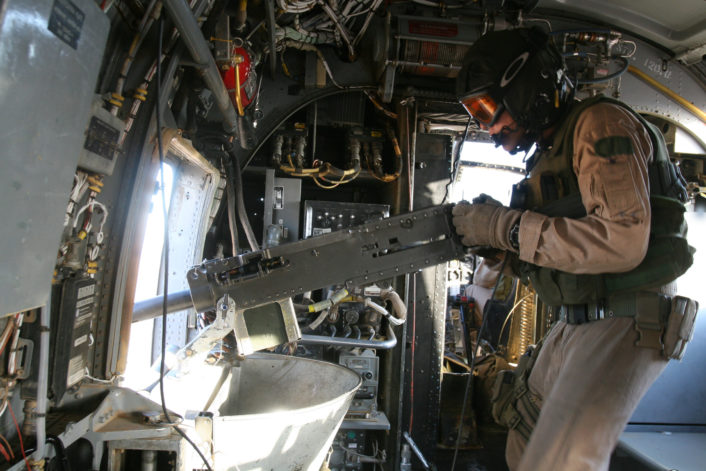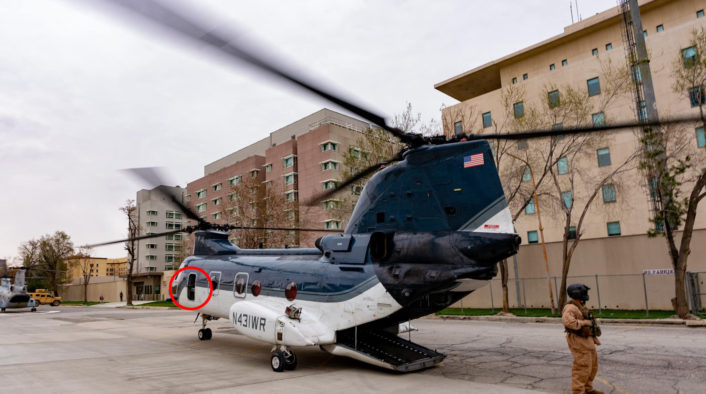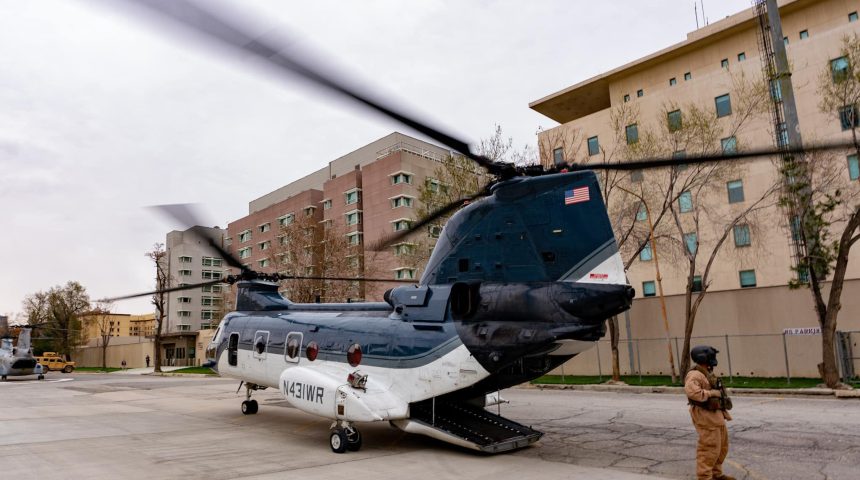The helicopter is part of a fleet used to support U.S. embassies in Afghanistan and Iraq.
Embassy Air is the name of an airline established in 2009 that operates a fleet of civil-registered Boeing CH-46E helicopters owned by the U.S. Department of State to support U.S. embassies in Afghanistan and Iraq with transportation tasks. Indeed, these choppers previously flown by the U.S. Marine Corps, are used to carry visiting VIPs or staff from the Airport to the U.S. Embassies in Kabul Baghdad and back, avoid having to use the risky ground transportation.
The CH-46Es are equipped with missile warning sensors and flare dispensers, located both under the fuselage in the forward section and above the rear sponsons, to counter MANPADS (Man Portable Air Defense Systems).
Depending on the security situation and threat posed by insurgents and other hostile actors, these helicopters can also be armed with machine guns (in fact, the CH-46s have provisions for 7.62mm M240D and for .50-caliber machine gun from the rear ramp or in windows on either side of the main cabin) although they usually don’t carry any weapons as they can be escorted by other armed assets, as the State Department’s UH-1N Twin Huey helos.

Noteworthy, a CH-46E, registered N431WR, supported Secretary of State Mike Pompeo diplomatic mission to Kabul on Mar. 23, 2020, for talks aimed at advancing three-week-old deal with the Taliban that sets a timetable for the U.S. to withdraw from Afghanistan by the middle of 2021. The images of the aircraft are interesting because they expose (from a different angle) another airframe known to operate for the airline besides the already “famous” N38TU and N701WN. Moreover, at least one of the images shows what appears to be a machine gun on the left hand side window.

As Joseph Trevithick has explained in great details in stories published at The War Zone here and here,
[Embassy Air] operates like a real airline with scheduled departures and arrivals that run five to six days a week, carrying as many as 150 people to and from the Embassy and other locations in the country every day. In the 2017 Fiscal Year, the CH-46 helicopters, which private military company DynCorp operates and maintains, flew a total of 32,000 scheduled flights, as well as 3,500 “special missions,” which would include activities such as moving the Secretary of State around during his visits, according to an official Department of State’s Office of the Inspector General review. You can read more about Embassy Air Program in Afghanistan, as well as in Iraq, here.
Trevithick points out that flying instead of driving has also the goal to prevent roadside IED (Improvised Explosive Device) or suicide attacks on Mine Resistant Ambush Protected (MRAP) armored trucks that can cause significant injuries to any civilian in the vicinity.
However, the Embassy Air flights are not cheap: according to a report released in September by the State Department Inspector General a 7-minute helicopter trip from the airport to the U.S. embassy in Afghanistan costs nearly $1,500, while a 1-hour plane journey in Iraq is priced at nearly $4,800, the report said. These high fares are hampering some diplomatic operations.
Stars and Stripes reported that:
High ticket prices have forced some offices to use other means of transportation, such as military or commercial airlines, and have forced officials to cancel visits to government project sites, the IG found in an audit of the airline, which maintains fleets of several planes and about two dozen helicopters in the two countries.
The $1,500 ticket price for a 7-minute helicopter trip from the U.S. Embassy in Kabul to nearby Camp Alvarado near the airport represents a nearly 400% increase from the price four years ago, the audit found.
A 1-hour flight from the Baghdad Diplomatic Support Center to the southern Iraq city of Basra, where the U.S. has a consulate, is priced at nearly $4,800, a 770% increase, it said.
The increases stem from a move by the board that oversees funding of the Embassy Air program to cover a larger share of operational costs through ticket sales instead of congressionally appropriated funds.
But, as ticket prices rose, ridership fell, and the IG audit found that officials did not routinely adjust the frequency of flights or the number of aircraft to align with changing demand.
As a result, the State Department “will continue to pay for significant costs associated with Embassy Air operations that are underused in addition to paying the costs associated with alternative modes of transportation,” the report said.
As a side note, it’s worth mentioning that in order to protect ground transportation from IEDs in the Afghan theatre, the Italian Air Force deployed to Heat, Afghanistan, for three years, its EC-27J JEDI (Jamming and Electronic Defense Instrumentation). From 2012 to 2014, the specially-modified C-27J Spartan was tasked with 2,800 flight hours of electronic activities in support of 800 ISAF missions across the whole country (from Jalalabad to Herat, to Kandahar and Murghab) that prevented the attackers from using electronic devices to remotely detonate any Improvised Explosive Device (IED).









